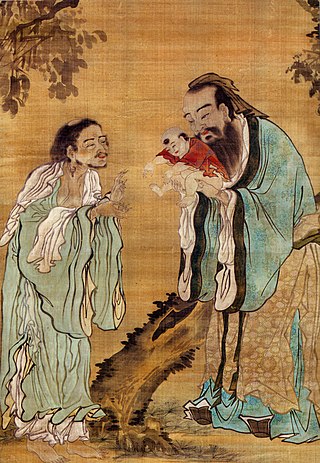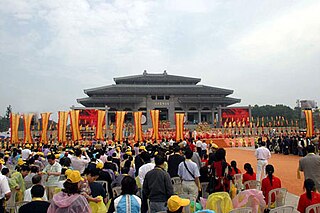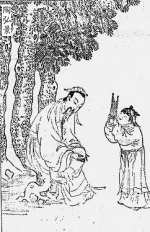Related Research Articles

Chinese philosophy originates in the Spring and Autumn period (春秋) and Warring States period (戰國時期), during a period known as the "Hundred Schools of Thought", which was characterized by significant intellectual and cultural developments. Although much of Chinese philosophy begun in the Warring States period, elements of Chinese philosophy have existed for several thousand years. Some can be found in the I Ching, an ancient compendium of divination, which dates back to at least 672 BCE.
The English words Daoism and Taoism are alternative spellings for the same-named Chinese philosophy and religion. The root for Daoism or Taoism is the Chinese word 道, which was transcribed tao or tau in the earliest systems for the romanization of Chinese and dao or dau in 20th century systems.

Taoism or Daoism refers to a set of Chinese traditions and religions which emphasize living in harmony with the Dao. The Dao is generally defined as the source of everything and the ultimate principle underlying reality. The Daodejing and the Zhuangzi are widely considered key Daoist texts.
Tao or Dao (道) is the natural order of the universe, whose character one's intuition must discern to realize the potential for individual wisdom, as conceived in the context of East Asian philosophy, East Asian religions, or any other philosophy or religion that aligns to this principle. This intuitive knowing of life cannot be grasped as a concept. Rather, it is known through actual living experience of one's everyday being. Its name, Tao or Dao(Chinese ), came from Chinese, where it signifies the way, path, route, road, or sometimes more loosely doctrine, principle, or holistic belief.

In Chinese philosophy, the three teachings are Confucianism, Taoism, and Chinese Buddhism considered as a harmonious aggregate. Literary references to the "three teachings" by prominent Chinese scholars date back to the 6th century. The term may also refer to a non-religious philosophy built on that aggregation.
The Three Treasures or Three Jewels are theoretical cornerstones in traditional Chinese medicine and practices such as neidan, qigong, and tai chi. They are also known as jing, qi, and shen.

Neidan, or internal alchemy, is an array of esoteric doctrines and physical, mental, and spiritual practices that Taoist initiates use to prolong life and create an immortal spiritual body that would survive after death. Also known as Jindan, inner alchemy combines theories derived from external alchemy, correlative cosmology, the emblems of the Yijing, and medical theory, with techniques of Taoist meditation, daoyin gymnastics, and sexual hygiene.

Buddhism has interacted with several Eastern religions such as Taoism, Shinto and Bon since it spread from the Indian subcontinent during the 2nd century AD.

In the study of comparative religion, the East Asian religions or Taoic religions, form a subset of the Eastern religions. This group includes Chinese religion overall, which further includes Ancestral Worship, Chinese folk religion, Confucianism, Taoism and popular salvationist organisations, as well as elements drawn from Mahayana Buddhism that form the core of Chinese and East Asian Buddhism at large. The group also includes Japanese Shinto, Tenrikyo, and Korean Muism, all of which combine Shamanistic elements and indigenous ancestral worship with various influences from Chinese religions. Chinese salvationist religions have influenced the rise of Japanese new religions such Tenriism and Korean Jeungsanism; as these new religious movements draw upon indigenous traditions but are heavily influenced by Chinese philosophy and theology.

Grandmaster Alex Anatole is a Taoist priest, teacher, and writer. He directs centers of Taoist studies in Europe, Australia and the United States.
The history ofTaoism stretches throughout Chinese history. Originating in prehistoric China, it has exerted a powerful influence over Chinese culture throughout the ages. Taoism evolved in response to changing times, with its doctrine and associated practices being revised and refined. The acceptance of Taoism by the ruling class has waxed and waned, alternately enjoying periods of favor and rejection. Most recently, Taoism has emerged from a period of suppression and is undergoing a revival in China.
Xuanxue, sometimes called Neo-Daoism (Neo-Taoism), is a metaphysical post-classical Chinese philosophy from the Six Dynasties (222-589), bringing together Taoist and Confucian beliefs through revision and discussion. The movement found its scriptural support both in Taoist and drastically reinterpreted Confucian sources. Xuanxue, or "Mystic Learning", came to reign supreme in cultural circles, especially at Jiankang during the period of division. The concept represented the more abstract, unworldly, and idealistic tendency in early medieval Chinese thought. Xuanxue philosophers combined elements of Confucianism and Taoism to reinterpret the I Ching, Daodejing and Zhuangzi.
Fangshi were Chinese technical specialists who flourished from the third century BCE to the fifth century CE. English translations of fangshi include alchemist, astrologer, diviner, exorcist, geomancer, doctor, magician, monk, mystic, necromancer, occultist, omenologist, physician, physiognomist, technician, technologist, thaumaturge, and wizard.
Albert Étienne Jean-Baptiste Terrien de Lacouperie was a French orientalist, specialising in comparative philology. He published a number of books on early Asian and Middle-Eastern languages, initially in French and then in English. Lacouperie is best known for his studies of the Yi Ching and his argument, known as Sino-Babylonianism, that the important elements of ancient civilization in ancient China came from Mesopotamia and that there were resemblances between Chinese characters and Akkadian hieroglyphics.
Huang–Lao or Huanglao was the most influential Chinese school of thought in the early 2nd-century BCE Han dynasty, having its origins in a broader political-philosophical drive looking for solutions to strengthen the feudal order as depicted in Zhou politics. Not systematically explained by historiographer Sima Qian, it is generally interpreted as a school of syncretism, developing into a major religion, the beginnings of religious Taoism.

Taoist meditation, also spelled Daoist, refers to the traditional meditative practices associated with the Chinese philosophy and religion of Taoism, including concentration, mindfulness, contemplation, and visualization. The earliest Chinese references to meditation date from the Warring States period.
The following outline is provided as an overview of and topical guide to Taoism:

Sino-Babylonianism is a theory now rejected by most scholars that in the third millennium B.C. the Babylonian region provided the essential elements of material civilization and language to what is now China. Albert Terrien de Lacouperie (1845–1894) first proposed that a massive migration brought the basic elements of early civilization to China, but in this original form the theory was largely discredited. In the early 20th century, Sinocentric arguments, sometimes based on Hua–Yi distinction appealed to Chinese intellectuals who wanted to believe that the Yellow Emperor and other figures were historical, not myths. Others reacted to the extent of denying that there were foreign elements in early China. In the late 20th and early 21st century, scholars have used newly excavated archeological evidence to argue that some particular elements of ancient Chinese civilization were carried from western or central Asia into China and that there are linguistic ties between the two sides of the Asian continent.

Tao Hongjing (456–536), courtesy name Tongming, was a Chinese alchemist, astronomer, calligrapher, military general, musician, physician, and pharmacologist, and writer during the Northern and Southern dynasties (420–589). A polymathic individual of many talents, he was best known as a founder of the Shangqing "Highest Clarity" School of Taoism and the compiler-editor of the basic Shangqing scriptures.
Taoist philosophy also known as Taology refers to the various philosophical currents of Taoism, a tradition of Chinese origin which emphasizes living in harmony with the Dào. The Dào is a mysterious and deep principle that is the source, pattern and substance of the entire universe.
References
- ↑ Albert Étienne Terrien de Lacouperie (1892), Catalogue of Chinese coins from the VIIth cent. B.C. to A.D. 621, Including the Series in the British Museum, Gilbert and Rivington, p. xi.
- ↑ Albert Terrien de Lacouperie (1892), The Oldest Book of the Chinese, the Yh-king, and its Authors, D. Nutt, pp. 114-115.
- ↑ Albert Étienne Terrien de Lacouperie (1894), Western Origin of the Early Chinese Civilisation from 2300 B.C. to 200 A.D.: or, Chapters on the Elements Derived from the old Civilisations of West Asia in the Formation of the Ancient Chinese Culture, Asher & Co., p. 147.